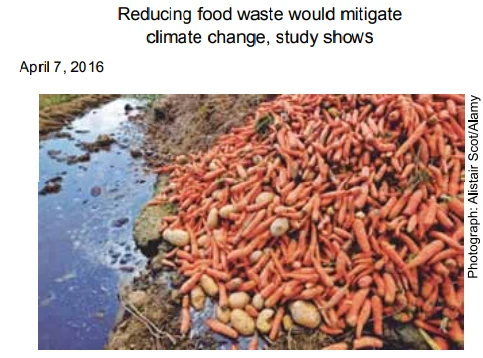Disciplina: Inglês 0 Curtidas
No trecho do quinto parágrafo “the potential for food - UNIFESP 2017

Reducing food waste around the world would help curb emissions of planet-warming gases, lessening some of the impacts of climate change such as more extreme weather and rising seas, scientists said on Thursday.
Up to 14% of emissions from agriculture in 2050 could be avoided by managing food use and distribution better, according to a new study from the Potsdam Institute for Climate Impact Research (PIK). “Agriculture is a major driver of climate change, accounting for more than 20% of overall global greenhouse gas emissions in 2010,” said co-author Prajal Pradhan. “Avoiding food loss and waste would therefore avoid unnecessary greenhouse gas emissions and help mitigate climate change.”
Between 30 and 40% of food produced around the world is never eaten, because it is spoiled after harvest and during transportation, or thrown away by shops and consumers. The share of food wasted is expected to increase drastically if emerging economies like China and India adopt western food habits, including a shift to eating more meat, the researchers warned. Richer countries tend to consume more food than is healthy or simply waste it, they noted.
As poorer countries develop and the world’s population grows, emissions associated with food waste could soar from 0.5 gigatonnes (GT) of carbon dioxide equivalent per year to between 1.9 and 2.5 GT annually by mid-century, showed the study published in the Environmental Science & Technology journal. It is widely argued that cutting food waste and distributing the world’s surplus food where it is needed could help tackle hunger in places that do not have enough – especially given that land to expand farming is limited.
But Jürgen Kropp, another of the study’s co-authors and PIK’s head of climate change and development, told the Thomson Reuters Foundation the potential for food waste curbs to reduce emissions should be given more attention. “It is not a strategy of governments at the moment,” he said.
(www.theguardian.com. Adaptado.)
No trecho do quinto parágrafo “the potential for food waste curbs to reduce emissions”, o termo em destaque indica
-
finalidade.
-
exclusão.
-
concordância.
-
acréscimo.
-
contraste.
Solução
Alternativa Correta: A) finalidade.
A alternativa A é a resposta correta porque, no trecho "the potential for food waste curbs to reduce emissions", a preposição "to" indica uma finalidade específica. Essa construção sugere que o objetivo das medidas de redução do desperdício de alimentos é a diminuição das emissões de gases de efeito estufa. Portanto, a intenção é clara: a ação de restringir o desperdício de alimentos é apresentada como uma estratégia com um propósito definido, que é a mitigação das emissões que contribuem para as mudanças climáticas.
O contexto do parágrafo reforça essa ideia ao mencionar que a redução do desperdício alimentar pode não apenas ajudar a enfrentar o problema das emissões, mas também combater a fome em regiões onde há escassez de alimentos. A expressão "the potential for food waste curbs to reduce emissions" evidencia essa conexão entre a ação de reduzir o desperdício e seu resultado desejado, ou seja, a redução das emissões. Assim, a preposição "to" é usada para expressar a finalidade da ação mencionada.
As outras opções não se aplicam ao contexto apresentado. Por exemplo, "exclusão", "concordância", "acréscimo" e "contraste" não refletem o significado da preposição "to" nesse caso. Portanto, a interpretação correta é que a expressão indica a finalidade da redução do desperdício de alimentos, confirmando a escolha da alternativa A.
Institução: UNIFESP
Ano da Prova: 2017
Assuntos: Interpretação Textual em Inglês
Vídeo Sugerido: YouTube